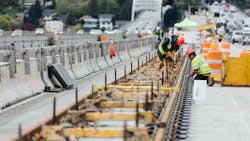Specialty infrastructure makes track installation on I-90 floating bridge possible
There is nothing straight forward about constructing light-rail infrastructure on top of a floating bridge. Rails must be able to accommodate lake motion - all six ranges of it; stray current risk must be eliminated; weight associated with standard track must be minimized and there is no precedent for such a method. Until now.
Sound Transit construction crews have been installing rail on the bridge for close to a year. Innovative track bridges accommodate lake motion and will enable light-rail vehicles to transition onto the floating bridge. Additionally, once on the bridge, the light-rail vehicles will operate over rails adhering to the bridge deck with specialized track attachments that minimize weight and isolate stray current from the electric system that powers the trains.
The specialty infrastructure required several years of planning and prep work, including building full-size track bridge prototypes that were tested at the Transportation Technology Center in Pueblo, Colo., and post-tensioning the bridge pontoons to reinforce the concrete with high-strength tensioned strands. Sound Transit explains that post-tensioning enables the bridge to withstand stronger winds and higher waves, as well as strengthen it to carry light-rail tracks and vehicles.
Tracks on the floating bridge are attached to light-weight concrete blocks, which sit on a layer of special shock-absorbing material called corkelast. A special polymer holds it all in place on the bridge deck without having to drill holes into the deck. Nearly 9,000 of these blocks, which also isolate stray current, are being affixed to the bridge deck using a DexG epoxy. Rail is set on the blocks with steel tie bars placed between them to maintain gauge.
Sound Transit says crews have installed one of the track bridges, which were engineered to compensate for the lake’s six ranges of motion and will allow light-rail trains to travel from the fixed sections of the bridge to the floating section. All eight of the track bridges are scheduled to be in place by the end of this year.
When the Blue Line opens in 2023, riders will be able to travel from Mercer Island to the University of Washington in 20 minutes; from South Bellevue to Sea-Tac Airport in 50 minutes; and from Redmond Technology to Bellevue Downtown in 10 minutes. It will also mark the first time light-rail trains operate over a floating bridge.
About the Author

Mischa Wanek-Libman
Group Editorial Director
Mischa Wanek-Libman is director of communications with Transdev North America. She has more than 20 years of experience working in the transportation industry covering construction projects, engineering challenges, transit and rail operations and best practices.
Wanek-Libman has held top editorial positions at freight rail and public transportation business-to-business publications including as editor-in-chief and editorial director of Mass Transit from 2018-2024. She has been recognized for editorial excellence through her individual work, as well as for collaborative content.
She is an active member of the American Public Transportation Association's Marketing and Communications Committee and served 14 years as a Board Observer on the National Railroad Construction and Maintenance Association (NRC) Board of Directors.
She is a graduate of Drake University in Des Moines, Iowa, where she earned a Bachelor of Arts degree in Journalism and Mass Communication.
